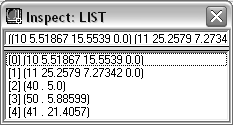You can pass the association list in the gp_PathData variable to the gp:drawOutline function by invoking the function as follows:
(gp:drawOutline gp_PathData)
Simple enough, but you also need to figure out how to process the information stored
in the association list. The Visual LISP Inspect feature can help you determine what
to do.
(setq BoundaryData (gp:getPointInput))
Visual LISP will store the information you provide in a variable named BoundaryData.
 Inspect from the Visual LISP menu.
Inspect from the Visual LISP menu.

Visual LISP displays a window like the following:

The Inspect window shows you each sublist within the BoundaryData variable.
(assoc 50 BoundaryData)
The assoc function returns the entry in the association list that is identified by the specified
key. In this example, the specified key is 50; this is associated with the angle of
the garden path (see Putting Association Lists to Use for a list of the key-value
pairs defined for this application).
(cdr (assoc 50 BoundaryData))
The cdr function returns the second element, and any remaining elements after that, from
a list. In this example, cdr retrieves the angle value, which is the second and last element in the entry returned
by the assoc function.
By this point, you should have no trouble understanding the following code fragment:
(setq PathAngle (cdr (assoc 50 BoundaryData))
Width (cdr (assoc 40 BoundaryData))
HalfWidth (/ Width 2.00)
StartPt (cdr (assoc 10 BoundaryData))
PathLength (cdr (assoc 41 BoundaryData))
u can pass the association list in the gp_PathData variable to the gp: drawOutline function by invoking the function as follows: (gp:drawOutline gp_PathData) …Association Lists. An association list, or a-list, is a data structure used very frequently in Lisp. An a-list is a list of pairs (conses); each pair is an association.association list , or alist for short, records a mapping from keys to values. It is a list of cons cells called associations : the car of each cons cell is the key , and …associations can be found just about everywhere. An internet search of the words “association” plus the name of your city may turn up a surprisingly large list …association list, often referred to as an alist, is a linked list in which each list element (or node) comprises a …list p q)) ;; <—- (display ( zip x y)) ;; ((1 4) (2 5) (3 6)). Result: http://www.ideone.com/ …… Elisp: Association List … Associative List (aka “alist”) is a datatype in Emacs Lisp. … There are functions that's designed for working with alist.… Deep integration into the language – many old commands work on …. The language support for Association s is approaching that for List -s.list of associations, which is also used in the case of ….. It seems to work but I do get interpretation warnings and the Objects are …lists, associations are fundamental constructs in the Wolfram Language. They associate keys with values, allowing highly efficient lookup and …
بنده سیامک دوستداری فارغ التحصیل رشته مکانیک سنگ از دانشگاه صنعتی اصفهان هستم، و در این وبسایت آموزش های مربوط به نحوه برنامه نویسی در اتوکد و هچنین آموزش تصویری دستورات اتوکد را قرار خواهم داد.
تلفن همراه: ۰۹۰۰۱۲۳۴۴۴۴
ایمیل: s.doostdari@gmail.com